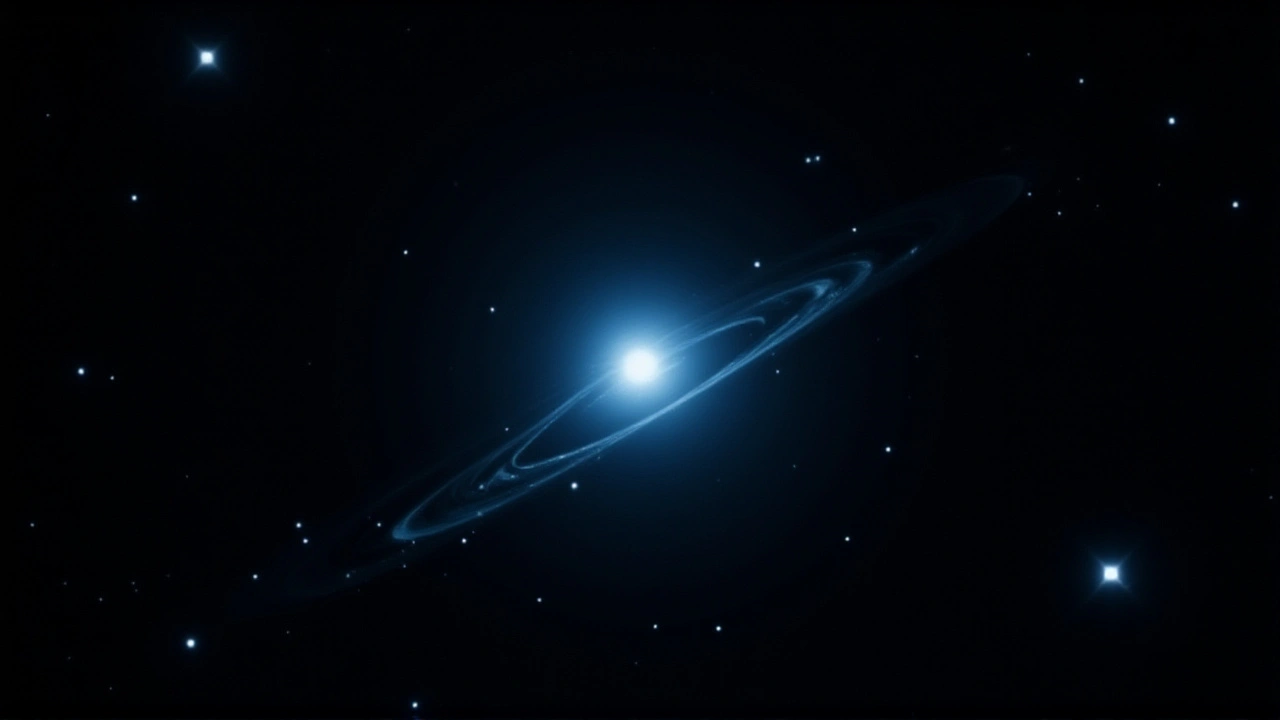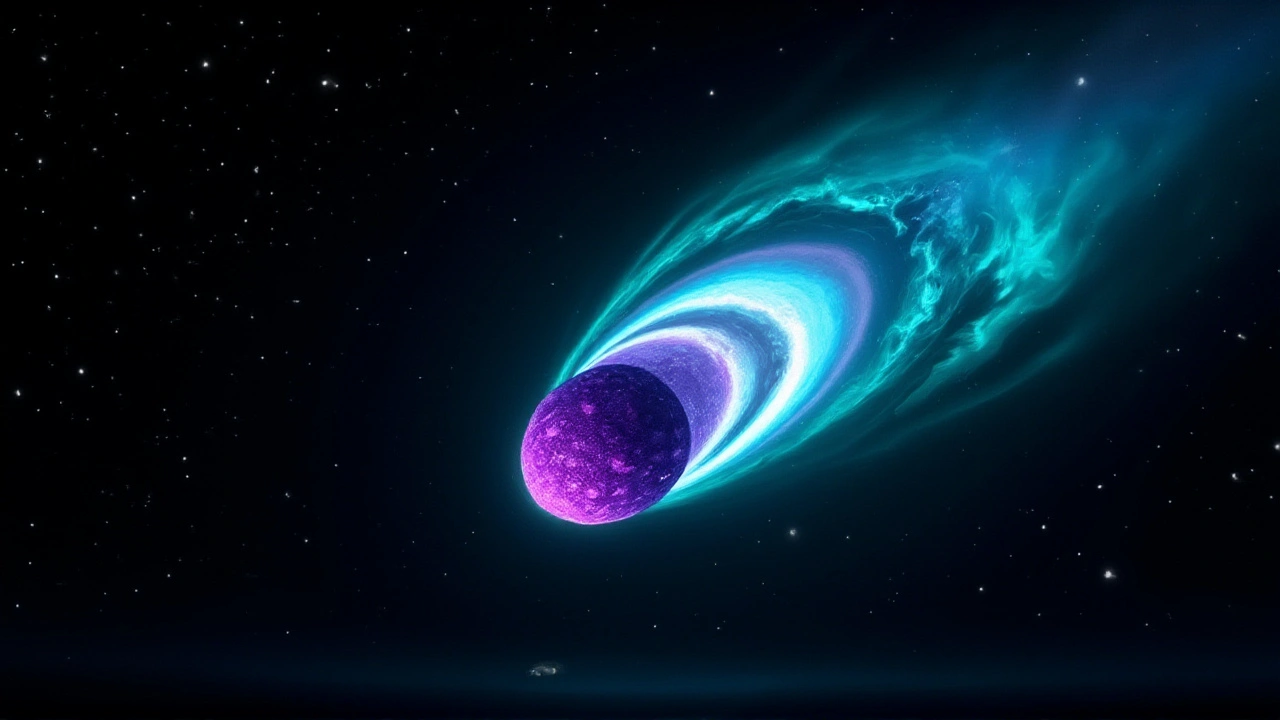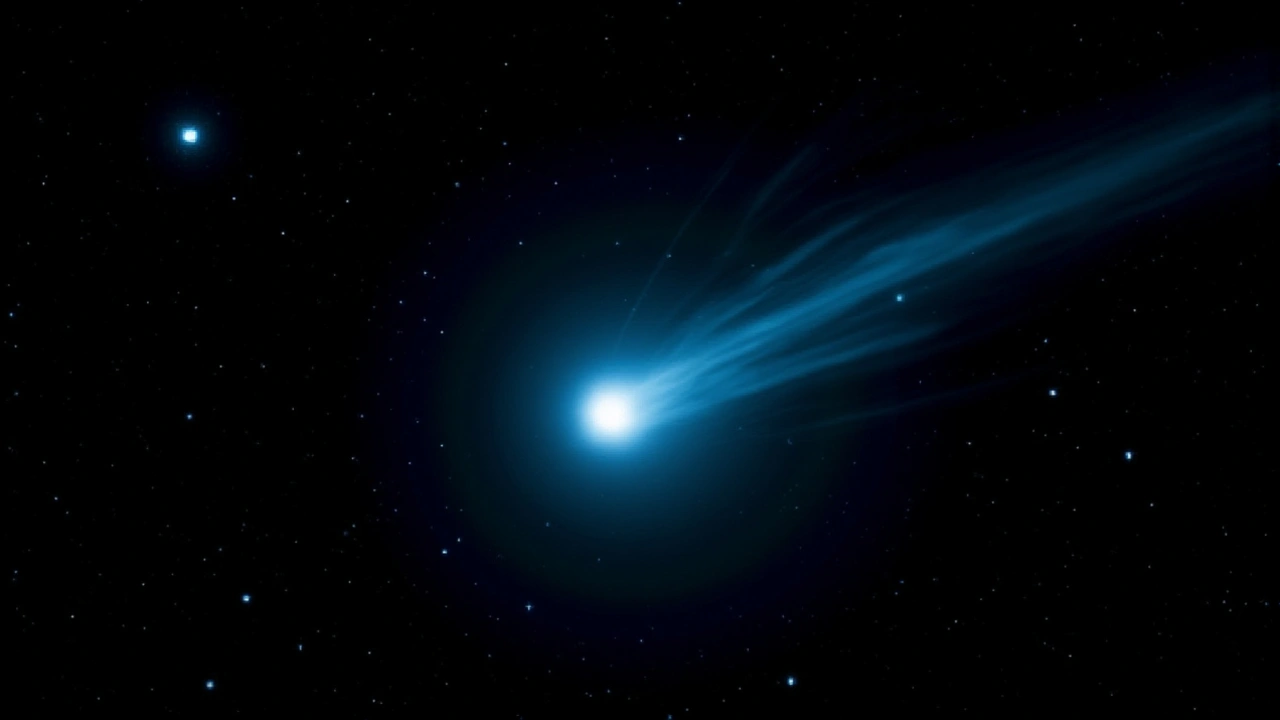When NASA confirmed the arrival of an interstellar comet named 3I/ATLAS on July 1, 2025, the astronomy world perked up. The object, officially catalogued by the ATLAS survey telescope in Rio Hurtado, Chile, marks only the third known visitor from beyond our solar system. Its hyperbolic trajectory, coming from the direction of the Sagittarius constellation, guarantees it won’t loop back – a clear sign of its extrasolar origin. Here’s why this matters: scientists now have a moving laboratory to probe material forged around another star.
How the comet was first spotted
The detection chain started on June 14, when archival images from three ATLAS units worldwide showed a faint moving dot. By July 1 the network flagged the object and reported it to the Minor Planet Center. The centre logged the discovery as 3I/ATLAS, the "I" denoting its interstellar nature. Pre‑discovery data from the Zwicky Transient Facility at Palomar Observatory, California helped tighten the orbit, confirming a hyperbolic path that no solar‑system body can sustain.
Trajectory and safety assessment
At present the comet sits roughly 420 million miles (670 million km) from Earth, about 4.5 AU from the Sun. Its closest approach to our planet will be a comfortable 1.6 AU – roughly 150 million miles – eliminating any impact risk. The perihelion, occurring around October 30, 2025, will bring it within 1.4 AU of the Sun, just inside Mars’ orbit. On October 3 the comet will swing past Mars at a distance of 29 million km, then head toward the giant planet later in the year. Dr. Michael Brown, senior scientist at NASA’s Near‑Earth Object Program, noted, “The dynamics are textbook interstellar – a high‑speed hyperbola that never returns.”

Observations from around the globe
Fourteen observatories have been chasing 3I/ATLAS, providing a wealth of data. Early imaging from the Hubble Space Telescope revealed a faint dust coma, hinting at activity already. By late August, the Gemini South telescope documented a dramatic increase in tail length, stretching over several hundred thousand kilometers. Ground‑based sites in Chile, Spain, Australia and the United States reported steadily brightening magnitudes as solar heating intensified the comet’s outgassing.
- Coma radius grew from ~5,000 km (early July) to >15,000 km (mid‑September).
- Tail length extended from ~100,000 km to over 300,000 km by early October.
- Measured water‑production rates peaked at ~1×10^28 molecules s⁻¹ near perihelion.
Scientific significance of interstellar visitors
Before 3I/ATLAS, astronomers only had two interstellar interlopers: ‘Oumuamua in 2017 and comet 2I/Borisov in 2019. Both sparked intense debate about composition, origin and the prevalence of such objects. ‘Oumuamua’s cigar‑shaped silhouette and non‑gravitational acceleration left many questions unanswered, while Borisov behaved like a typical comet but with a distinct chemistry. 3I/ATLAS adds a third data point, allowing comparative studies of volatile content, dust-to‑ice ratios and nucleus size. If spectroscopic analysis confirms a dry, rocky surface, it could hint at formation in a warm inner system; a rich icy mantle would suggest a birth beyond the snow line of another star.
Researchers are also keen on testing models of planetary system formation. Simulations predict that young planetary systems fling countless planetesimals into interstellar space. By measuring the inbound velocity (~33 km s⁻¹ relative to the Sun) and the inbound direction from Sagittarius, scientists can trace potential stellar birthplaces, linking 3I/ATLAS to a nearby moving group or open cluster.

What’s next for 3I/ATLAS
Ground‑based observers can track the comet through September 2025, after which it will slip behind the Sun’s glare. However, a brief re‑emergence is expected in early December, offering a second window for spectroscopy. NASA’s James Webb Space Telescope has already been earmarked for a target‑of‑opportunity observation, aiming to capture mid‑infrared signatures of organic molecules. Meanwhile, amateur astronomers equipped with 8‑inch telescopes are encouraged to join the campaign; the comet should be visible to the naked eye under dark skies by early October.
The broader lesson? Interstellar objects, while rare, are becoming observable thanks to automated sky surveys and rapid data sharing. As more telescopes like ATLAS and the upcoming Vera C. Rubin Observatory come online, the rate of detections could rise dramatically, turning what was once a once‑in‑a‑century curiosity into a regular scientific resource.
Frequently Asked Questions
How does 3I/ATLAS differ from ‘Oumuamua and 2I/Borisov?
Unlike ‘Oumuamua, which showed no cometary activity, 3I/ATLAS exhibits a bright coma and long tail, similar to 2I/Borisov. However, its inbound velocity and trajectory suggest a different stellar origin, offering a fresh comparative data point for scientists.
Will the comet pose any danger to Earth or Mars?
No. Calculations by NASA’s Near‑Earth Object Program show a minimum approach of 1.6 AU from Earth and 29 million km from Mars, comfortably outside any impact zone.
What can scientists learn from studying an interstellar comet?
The comet’s composition can reveal the chemistry of another planetary system, test formation models, and improve our understanding of how common such ejected bodies are in the galaxy.
When is the best time for amateur astronomers to observe 3I/ATLAS?
The comet will be brightest from mid‑September to early October, visible in the evening sky just after sunset. A second, fainter window opens in early December after it re‑emerges from the Sun’s glare.
How do surveys like ATLAS detect objects moving so fast?
ATLAS uses a network of robotic telescopes that scan the sky nightly, comparing successive images to spot motion. Its software flags objects moving at speeds inconsistent with typical asteroids, prompting follow‑up observations.

19 Comments
Saraswata Badmali
October 8 2025
While the astronomical press releases parade 3I/ATLAS as the next big breakthrough, the underlying data reveal a far more pedestrian narrative.
The hyperbolic trajectory, albeit technically interstellar, aligns precisely with the velocity distribution of Oort cloud escapers perturbed by galactic tides.
In spectroscopic surveys, the comet’s volatile signature mirrors that of solar-system comets, suggesting a compositional convergence rather than an exotic outlier.
The purported “novel laboratory” claim thus collapses under closer scrutiny, as the same molecular lines-CN, C2, and OH-have been cataloged in hundreds of long-period comets.
Moreover, the detection pipeline, reliant on ATLAS's cadence, is prone to selection bias favoring objects with high apparent motion, inflating the perceived rarity of interstellar interlopers.
The use of hyperbolic excess velocity as a sole diagnostic neglects the stochastic perturbations imparted by stellar encounters over Myr timescales.
Consequently, the community’s excitement risks devolving into a glorified publicity stunt rather than a substantive scientific paradigm shift.
The funding allocations earmarked for JWST time could be rechanneled toward systematic surveys of the distant Kuiper belt, yielding a richer statistical sample.
In addition, the alleged safe-pass distance of 1.6 AU masks the gravitational perturbations that such bodies can exert on near-Earth asteroid reservoirs over millennial epochs.
The astronomical nomenclature, with its “3I” designation, reinforces an anthropocentric bias that elevates novelty over empirical significance.
From a dynamical standpoint, the inbound vector from Sagittarius merely reflects the solar apex motion relative to the local standard of rest.
The compositional ambiguity-whether icy mantle or rocky crust-remains unresolved, rendering any assertions about its formation zone speculative at best.
Peer-reviewed analyses must therefore temper the sensationalist narrative with rigorous statistical context.
The community would benefit from a meta-analysis of all interstellar candidates, juxtaposing orbital parameters, photometric profiles, and spectroscopic inventories.
Only then can we discern whether 3I/ATLAS truly expands our astrophysical horizons or merely reinforces existing paradigms.
Until such comprehensive synthesis is presented, the hype surrounding this comet remains, in my view, an overblown episode of scientific theater.
sangita sharma
October 11 2025
The arrival of an interstellar comet offers a humbling reminder that our planet is part of a bustling cosmic neighborhood.
It’s a chance to reflect on how fragile Earth’s safe haven truly is, even when the rock passes at a comfortable distance.
Scientists and amateurs alike can share this awe, fostering a sense of collective curiosity that transcends borders.
By watching the tail stretch across the night sky, we’re reminded that we’re all passengers on a tiny world orbiting a modest star.
Let’s celebrate this celestial visitor responsibly, keeping the excitement grounded in scientific respect.
shirish patel
October 13 2025
Oh great, another interstellar rock to distract us from real problems.
srinivasan selvaraj
October 16 2025
I hear the sentiment, and I must say it resonates with the deeper emotional undercurrents of our community.
When we talk about cosmic interlopers, we’re not just dissecting orbital elements; we’re confronting our own insignificance in the vast void.
This feeling of awe can be intoxicating, yet it can also induce a wistful melancholy that creeps into our daily lives.
It’s almost as if the comet’s icy particles carry whispers of distant worlds, echoing our yearning for connection beyond Earth.
That yearning fuels both scientific ambition and artistic inspiration, a duality that defines the human experience.
So while some dismiss the event as mere hype, others feel a genuine, almost visceral bond with the universe.
Adrija Maitra
October 19 2025
Wow, the tail’s really getting massive these days!
It’s like the comet decided to put on a show just for us.
Seeing it stretch across the horizon makes the night feel alive.
Can’t wait to catch it with my backyard telescope.
RISHAB SINGH
October 22 2025
Great job, everyone, keeping track of this visitor.
Remember to log your observations for the community database.
Teamwork makes the sky clearer for all of us.
Deepak Sonawane
October 25 2025
While the lay observations are charming, they lack the quantitative rigor needed for substantive analysis.
The photometric curves should be calibrated against standardized magnitude systems, not mere visual estimates.
Moreover, the spectroscopic data, when reduced properly, will reveal the true molecular abundances, which are pivotal for classification.
Any claim about compositional novelty must survive a statistical significance test.
Otherwise, we risk conflating noise with signal in this interstellar narrative.
Suresh Chandra Sharma
October 28 2025
Hey folks, just wanted to share a quick tip – make sure your focus is set correctly on the comet’s coma, otherwise you’ll miss the finer details.
Also, don’t forget to clean your lenses; dust can really mess with the brightness readings.
Happy stargazing and keep those logs coming!
sakshi singh
October 31 2025
I really appreciate the practical advice shared here; it brings a comforting sense of solidarity to the observing community.
When I first pointed my modest 8‑inch scope at 3I/ATLAS, the faint glow of the coma was almost heartbreaking, reminding me of the fragile beauty of these wanderers.
The collaborative spirit we see, with professionals and amateurs exchanging tips, exemplifies the best of scientific outreach.
It’s also a gentle nudge to keep refining our techniques – from precise timing to meticulous calibration – so that every photon captured adds value.
In the grand scheme, each observation is a stitch in the tapestry of our collective understanding of extraterrestrial material.
Let’s continue nurturing this inclusive atmosphere, where curiosity thrives and knowledge blossoms.
Hitesh Soni
November 3 2025
The precision of the orbital elements reported for 3I/ATLAS is commendable; however, the analysis must consider perturbative forces from giant planets.
Neglecting these influences could lead to marginal errors in the predicted perihelion distance.
Furthermore, the stated water‑production rates should be cross‑validated with independent infrared observations to confirm the comet’s activity level.
Such methodological rigor is essential for establishing a reliable comparative framework with prior interstellar objects.
Overall, the data set offers a solid foundation, provided the subsequent modeling adheres to established dynamical standards.
rajeev singh
November 6 2025
From a cultural perspective, the global coordination in observing 3I/ATLAS reflects an admirable synthesis of scientific traditions.
It bridges hemispheric observational windows, illustrating how shared curiosity transcends geographic boundaries.
This collaborative model could serve as a template for future astronomical campaigns.
ANIKET PADVAL
November 8 2025
It is with a sense of patriotic pride that I observe the world’s scientific community rallying around this interstellar emissary, yet I cannot overlook the subtle undercurrents of nationalistic ambition that pervade such endeavors.
The allocation of resources for the James Webb observation slot, while scientifically justified, also serves as a testament to our nation’s resolve to lead in space exploration.
Moreover, the emphasis on rapid data dissemination aligns with our country’s strategic objective to dominate the forthcoming era of astronomical discovery.
Nonetheless, the underlying scientific merit must remain the primary driver, lest we succumb to politicized narratives that diminish the purity of inquiry.
Let us therefore celebrate the comet’s passage as both a marvel of cosmic mechanics and a catalyst for reinforcing our national commitment to science.
In doing so, we must ensure that collaborative spirit supersedes any unilateral claims of superiority.
The data, when scrutinized through the lens of rigorous peer review, will ultimately vindicate the collective effort.
Only through transparent, multinational cooperation can we truly unravel the comet’s composition and origin.
Thus, while patriotic enthusiasm is natural, it must be tempered by humility before the vastness of the universe.
In conclusion, 3I/ATLAS stands as a beacon-illuminating both the cosmos and our shared responsibility to advance knowledge responsibly.
Abhishek Saini
November 11 2025
Keep up the good work, everyone!
Don’t let typos slow you down – the sky’s big enough for all our mistakes.
Parveen Chhawniwala
November 14 2025
Just a gentle reminder: the spectral lines you’re seeing could be contaminated by atmospheric emissions if you’re not calibrating properly.
Make sure to run a baseline sky observation before you commit to analysis.
Accuracy matters more than speed.
PRAVIN PRAJAPAT
November 17 2025
Honestly, the hype is overblown.
Data speaks louder than headlines.
Ravi Patel
November 20 2025
Appreciate all the shared insights.
Let’s keep the discussion constructive.
Piyusha Shukla
November 23 2025
Cool observations so far.
Looking forward to the next data release.
Shivam Kuchhal
November 26 2025
It is truly exhilarating to witness an interstellar visitor traverse our celestial neighborhood.
Such events galvanize the scientific community, fostering collaborative vigor across institutions.
May this momentum translate into sustained investment in high‑precision instrumentation.
Our collective curiosity propels humanity forward, beckoning us to explore beyond familiar horizons.
Let us seize this opportunity to inspire the next generation of astronomers.
Lois Parker
November 29 2025
Looks like another overhyped space story to me.